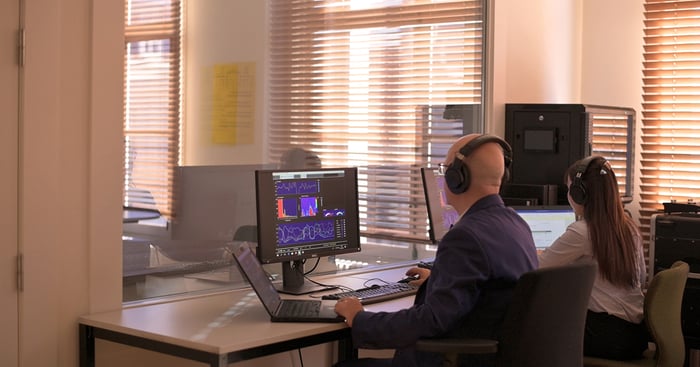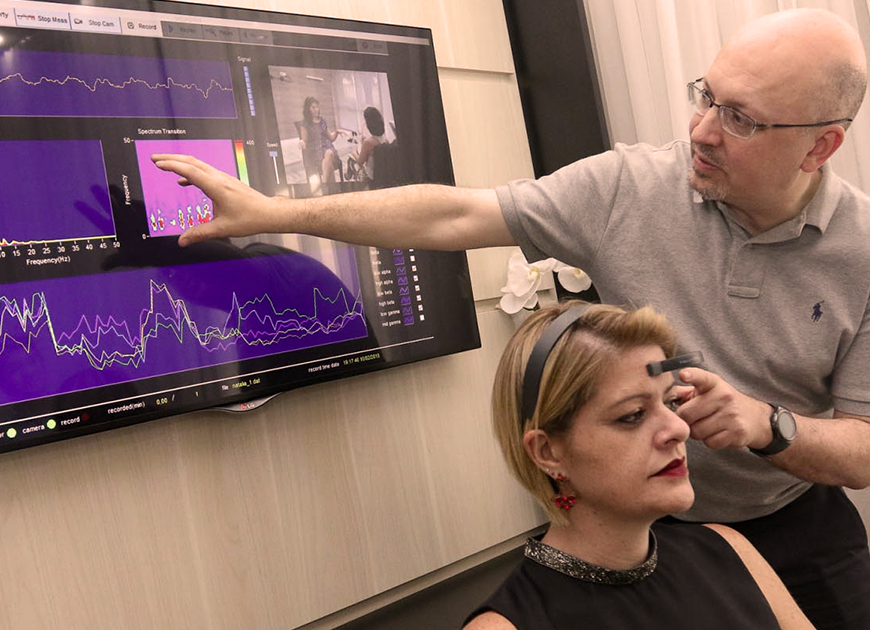What happens in the brains of successful and less successful leaders? Steven Poelmans, professor of neuroscience & strategic leadership, measures their brain activity and combines the results with feedback from observers in real-life and emotionally challenging business situations. This shows that successful leaders can very quickly switch between diametrically opposed leadership styles.
This article was written by Hilde Vereecken and appeared in HR.Square.
Insights from neuroscience can help to improve self-awareness and self-knowledge and thus to become a better leader. This is what we call neuroleadership. "All kinds of disciplines have been using insights from neuroscience to fine-tune their theories for quite some time now. This creates relatively new domains such as neuroeconomics, neuroethics, neuromarketing and now also neuroleadership," says Steven Poelmans, professor of neuroscience & strategic leadership. He holds the Melexis Endowed Chair of Neuroscience- and Technology-enabled High Performance Organizations at Antwerp Management School. He is also director of the NeuroTrainingLab™, with labs in Spain, Chile, Belgium, Brazil, and Argentina. The NeuroTrainingLab™ in Belgium is a partnership between Antwerp Management School and Acerta.

Biometric sensors
Technological progress is one of the main reasons for the trend to apply insights from neuroscience in other domains. For example, new techniques allow us to see in real time what is happening in the brain while someone is performing a task. "The rise of wearable technology also makes it possible to collect useful biometric information in a user-friendly way. This is especially important for applied research into e.g. leadership. After all, leadership is about emotional and social intelligence, and the best way to research this is in real-life situations. Our research is based on what we observe in leaders, i.e. based on what leaders do and not on what they say they do", Poelmans explains.
In the NeuroTrainingLab™, Poelmans observes the participants’ neuroactivity or electroencephalographic (EEG) activity as they are confronted with an emotionally challenging business situation, such as team members provoking conflict. "The brain activity measured through biometric sensors is processed via software into three indicators: the degree of engagement or stress, the ability to focus attention externally and the ability to concentrate and reflect. This gives us insight into the stress level and activity of the prefrontal cortex.
In addition, trained observers monitor the participans’ facial expression, body language and verbal behavior. This verbal behavior is then translated into competencies. After all, competencies are observable behaviors that occur with a certain regularity and can therefore be associated with someone's work performance. In this way we can make a second-by-second link between behavior and what happens in the brain. This is what makes our research unique.”
"We can link behavior with what is happening in the brain second by second. This is what makes our research unique."
Brain flexibility
One question that sometimes pops up, is whether Poelmans is looking for a biological marker or a measurable indicator of leadership. "In a way I am, although our research shows that there is no specific signal lighting up somewhere in the brain. Our research shows that leaders can very quickly switch between behaviors associated with specific activities in neural networks. In other words, we see that good leaders can switch very quickly between many different mental states. This brain flexibility allows them to quickly switch between concentration and problem-solving, to more empathic behavior both towards themselves and towards others, and then to switch back to long-term thinking. Moreover, they are able to look at themselves and the situation from a third perspective and make decisions from there: ‘That doesn’t work, I need to try something else’ or ‘Oops, I seem to have touched a nerve here, so I have to be respectful and tread carefully’. That is what we call metacognition or thinking about thinking. It is a form of higher consciousness, also called mindfulness.”
"Metacognition or thinking about thinking, is a form of higher consciousness, also called mindfulness.”
The moment of insight
Biometric signals can be used to measure whether someone is in a state of mindfulness. "Someone who is in a state of mindfulness, is calm and serene, has a low stress level and is at the same time highly focused and very much present in the here and now. But simultaneously, he can also focus his attention externally, for instance on the reaction of an employee”, Poelmans says.
He points to yet another universal biomarker that refers to the moment of insight. "The moment at which someone gains insight–the so-called eureka moment–we see a peak in gamma activity and a suppression of the visual cortex. Moreover, research shows that people who are in a state of mindfulness more easily gain insights and are thus more creative. He emphasizes, though, that every human being is unique because of the unique experiences we have, which in turn create unique associations that are reflected in specific neuronal networks. "Or to put it with the American neuroscientist and neuropsychologist Joseph LeDoux: 'We are our synapses'. LeDoux focuses primarily on research into emotions. At the NeuroTrainingLab™ we look at cognitive activity as well as the emotional and social intelligence of participants."
In collaboration with Acerta, Poelmans also investigates whether adaptability can be developed, and which interventions have the greatest impact on cognitive, emotional, and social skills related to adaptability.
The malleable brain
From observing behavior and related brain activity to training and development is just a small step. "We can train our brains and change our way of thinking to make better and empathic decisions, especially in times of stress. Participants are faced with real-life cases, realistically presented by professional actors who are trained to improvise. The supervisors observe how the participants interact with the actors under pressure, and their reactions are visualized through biometric data. Right after the exercise, the participants receive task-oriented feedback. By combining biometric data with the observers' feedback, the participants gain insight into the what, how and why of their reactions. They can use these insights to improve their emotional intelligence", Poelmans outlines.

He also points out the importance of the brain-friendly way of giving feedback for the learning process. "We very strongly emphasize creating psychological safety, which is crucial for the learning process. In addition, we give feedback based on objective data. When feedback is not based on a person's opinion, which can often come across as criticism, you are much more receptive to feedback. Moreover, we only use the method in the context of training and development rather than selection purposes. During an assessment center, evaluation anxiety arises, because after all, a job or a promotion is at stake, and that is not the kind of stress we want to see during the exercises. Although that does not mean that we go easy on the participants.
The exercises deliberately provoke stress, since the participants find themselves in socially difficult situations. The intention is to learn to control them under pressure. The actors are authentic in their emotions, they react in a lifelike way. It is not about a theatrical performance but about real emotions.” Moreover, he emphasizes that biometric data in themselves cannot predict future work performance. Only behavior and competencies can do that. "Neurological activity must always be interpreted combined with how someone behaves in a certain situation. Although this interaction can certainly be virtual."
Paradoxical leadership
From their observations in the NeuroTrainingLab™ over the past eight years, Poelmans and his team conclude that successful leaders are very good at dealing with the paradoxes of leadership. "When we see leaders in action at the lab, we notice that they are able to switch very quickly between different and often opposing leadership styles. During complex interactions they manage to switch very smoothly and in a split second from, for instance, a task-oriented approach to a more relationship-oriented approach. And that in the same context and with the same people”, Poelmans says. He calls this paradoxical leadership. "This goes one step beyond situational leadership, in which one acts as a manager or coach depending on the person and the context. With paradoxical leadership one is both managing and coaching at the same time, thus succeeding in balancing both poles of a leadership style. So it's about attaining both instead of choosing one", Poelmans explains.
A successful leader may one moment rule with an iron fist, and the next with a velvet glove. Employees expect clear decisions and guidelines while at the same time wanting sufficient autonomy and trust. "At first glance, this may seem like a contradiction, but it is not. Compare it to yin and yang: two opposing forces that seemingly contradict each other, while they are actually balancing each other out to form a dynamic whole that is greater than the sum of its parts. A classic paradox, for instance, is operational efficiency versus disruptive innovation. Both are important for an organization's survival in turbulent times", he explains.
"Different leadership behaviors require the activation of different neuronal circuits in the brain, but they cannot be activated at the same time.”
Balancing both poles of a paradox or quickly switching between leadership styles requires a lot of energy. "Different leadership behaviors require the activation of different neuronal circuits in the brain, but they cannot be activated at the same time. We thus notice that to keep the balance between these paradoxical behaviors, leaders engage in a specific form of multitasking, which scientists call dual-task processing. This requires not only metacognition and mental flexibility to know when to switch between mindsets, but also sufficient resilience to quickly recover from cognitive overload, emotional attacks, and social confrontations."
Cowboys and Indians
Finally, Poelmans addresses some of the criticisms of this still fledgling science. "A number of neuroscientists are distrustful of domains such as economics, ethics or psychology venturing into their field. Or they are skeptical about technological evolutions such as the rise of wearable technology. These are the Indians or natives who respond condescendingly to how technology drives science and vice versa. Nevertheless, there are sufficient indications that neuroleadership is becoming a solid scientific domain.
Even though it is still a relatively new domain, more and more scientific research is being conducted into this topic, and there are more and more scientific publications on the subject. At international scientific congresses, more and more sessions dedicated to neuroleadership are being organized. On the other hand, there are also the Cowboys shooting from the hip. They have read a few articles and are already thinking of quick profits. But these are phenomena that every new field of research has to contend with.”



